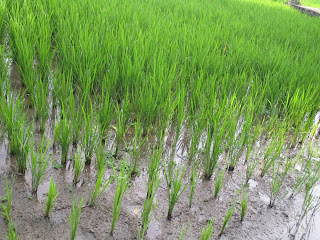1: The Seed Stage
If you have seen or eaten any rice, you have seen the plant in this stage. We humans eat rice seeds with many meals, as they are very good at soaking up flavor. Rice seeds are also good at absorbing water. If you get your phone dangerously wet, the rice helps by taking out the water. If you plant a rice seed you find at the grocery store and water it every day, odds are it won’t sprout.
Rice needs proper growing conditions, and A LOT of water. Basically take a field, and replace all the grass with rice seeds, and you will be hopefully (although I can’t really try it out, but that seems to be how the rice farmers do it) a highly successful planter. In the photo, the seeds are growing on a mature rice plant.
2: The vegetative stage
This stage starts when the plant sprouts, and continues until the plant reproduces. At first, there are just a few chutes of grass-like stalks, but as it continues growing, it gets taller and taller until it looks like this.
The picture on the right is what it looks like when the rice has just sprouted compared to its more mature vegetative stage. The rice plant usually takes just 3-4 months until it is mature, but can take up to 6 depending on the species. When the plant is grown enough, it is ready to move on to the next part of its life.
3: The Reproductive Stage
These plants are reproducing, which means that they are growing the seeds so they can be planted next year. Over time, the flowers are growing, and will bloom as soon as they are ready (although, don’t expect them to be particularly beautiful.) As they reproduce, the plants continue to grow, and they may get to be even taller than the ones in the back. Because of all the water they need the rice is a great breeding ground for many insects, bugs, flies, and even birds!
4: The Ripening Stage
Like with most plants, the rice ripens as it flowers. This process just takes a few days, but somewhere in that timeframe, the rice reaches its full height. Most species are between 2 and 4 feet, but some can be as tall as 6. The rice keeps producing and ripening its seeds until the end of its life. Domesticated rice gets harvested when it is ready&ripe. The fruit is tiny and inedible, juste rice seeds can be eaten as soon as it is ripe. After domesticated rice is fully harvested, it is burned, so the field can be used next year. This process can take a long time though, since the field is so wet. If the rice is not domestic, it dies, as is the circle of life.
REFERENCES:
http://www.yara.co.tz/crop-nutrition/crops/rice/key-facts/life-cycle-of-the-rice-plant/
https://www.statista.com/topics/1443/rice/
Rice-growing time-lapse--112-day growth cycle in 1 minute, 10 seconds
FUN FACTS
1 478,441 tons of rice are consumed yearly
2 China consumes almost 1/2 of that
3 Rice has been discovered in mediaeval Chinese walls that they put in for strength
4 Thailand is the #1 exporter of rice
5 There are over 40,000 different species of rice
6 Rice grows in every continent except Antarctica
7 A common Thai greeting translates to “have you consumed rice yet?”
8 The average Burmese person consumes about 500 pounds of rice a year.
9 The value of all rice produced in the U.S. yearly is $2,579,001
10 Rice is a symbol of life, and is often thrown at weddings.
NOTE TO BLOGGERS
I added pictures to the report, but after I copied and pasted, they weren't on the blog. I'm sorry that you didn't get to see them. (don't worry, I added them! --- Chris)












No comments:
Post a Comment